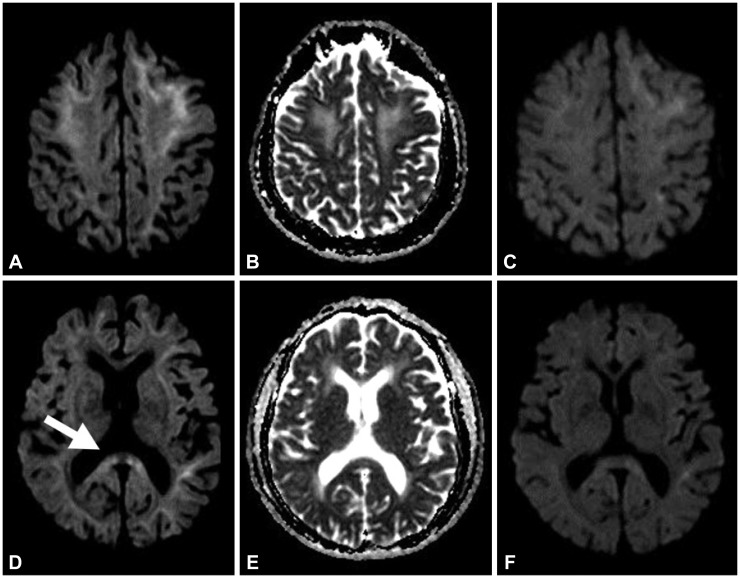Dement Neurocogn Disord.
2017 Sep;16(3):83-86. 10.12779/dnd.2017.16.3.83.
A Case of Scrub Typhus Related Encephalopathy Presenting as Rapidly Progressive Dementia
- Affiliations
-
- 1Department of Neurology, Kangwon National University Hospital, Chuncheon, Korea. movement@kangwon.ac.kr
- 2Department of Neurology, Kangwon National University School of Medicine, Chuncheon, Korea.
- 3Department of Internal Medicine, Kangwon National University School of Medicine, Chuncheon, Korea.
- 4Department of Radiology, Kangwon National University School of Medicine, Chuncheon, Korea.
- KMID: 2442821
- DOI: http://doi.org/10.12779/dnd.2017.16.3.83
Abstract
- BACKGROUND
An infection known to be a major cause of mild encephalitis/encephalopathy with a reversible splenial lesion (MERS). Rapidly progressive dementia is a neurological condition in which dementia progresses in a short period of time.
CASE REPORT
We report on a 78-year-old woman presenting with a rapid decline in cognitive function resulting from a scrub typhus infection. Diffusion weighted images showed a signal intensity at the splenium, and subcortical white matter of both hemispheres suggesting MERS. On the neuropsychological test, the patient showed frontal executive dysfunction.
CONCLUSIONS
This case suggests that diagnosticians should consider the possibility that a MERS patient with a rapidly cognitive decline could have a scrub typhus infection because early diagnosis of scrub typhus is very important in this aspect of the treatment.
Keyword
MeSH Terms
Figure
Reference
-
1. Tada H, Takanashi J, Barkovich AJ, Oba H, Maeda M, Tsukahara H, et al. Clinically mild encephalitis/encephalopathy with a reversible splenial lesion. Neurology. 2004; 63:1854–1858. PMID: 15557501.
Article2. Avcu G, Kilinc MA, Eraslan C, Karapinar B, Vardar F. Mild encephalitis/encephalopathy with reversible splenial lesion (MERS) associated with Streptococcus pneumoniae Bacteraemia. J Infect Public Health. 2017; 10:479–482. PMID: 27641480.
Article3. Kelly DJ, Fuerst PA, Ching WM, Richards AL. Scrub typhus: the geographic distribution of phenotypic and genotypic variants of Orientia tsutsugamushi. Clin Infect Dis. 2009; 48(Suppl 3):S203–S230. PMID: 19220144.4. Zhang L, Bi Z, Kou Z, Yang H, Zhang A, Zhang S, et al. Scrub typhus caused by Orientia tsutsugamushi Kawasaki-related genotypes in Shandong Province, northern China. Infect Genet Evol. 2015; 30:238–243. PMID: 25575441.
Article5. Kim DM, Chung JH, Yun NR, Kim SW, Lee JY, Han MA, et al. Scrub typhus meningitis or meningoencephalitis. Am J Trop Med Hyg. 2013; 89:1206–1211. PMID: 24166036.
Article6. Rana A, Mahajan SK, Sharma A, Sharma S, Verma BS, Sharma A. Neurological manifestations of scrub typhus in adults. Trop Doct. 2017; 47:22–25. PMID: 27059055.
Article7. Paterson RW, Takada LT, Geschwind MD. Diagnosis and treatment of rapidly progressive dementias. Neurol Clin Pract. 2012; 2:187–200. PMID: 23634367.
Article8. Sala I, Marquié M, Sánchez-Saudinós MB, Sánchez-Valle R, Alcolea D, Gómez-Ansón B, et al. Rapidly progressive dementia: experience in a tertiary care medical center. Alzheimer Dis Assoc Disord. 2012; 26:267–271. PMID: 22001379.9. Geschwind MD, Shu H, Haman A, Sejvar JJ, Miller BL. Rapidly progressive dementia. Ann Neurol. 2008; 64:97–108. PMID: 18668637.
Article10. Josephs KA, Ahlskog JE, Parisi JE, Boeve BF, Crum BA, Giannini C, et al. Rapidly progressive neurodegenerative dementias. Arch Neurol. 2009; 66:201–207. PMID: 19204156.
Article11. Almeida OP, Lautenschlager NT. Dementia associated with infectious diseases. Int Psychogeriatr. 2005; 17(Suppl 1):S65–S77. PMID: 16240484.
Article12. Lee HW, Cho PY, Moon SU, Na BK, Kang YJ, Sohn Y, et al. Current situation of scrub typhus in South Korea from 2001-2013. Parasit Vectors. 2015; 8:238. PMID: 25928653.
Article13. Kweon SS, Choi JS, Lim HS, Kim JR, Kim KY, Ryu SY, et al. Rapid increase of scrub typhus, South Korea, 2001-2006. Emerg Infect Dis. 2009; 15:1127–1129. PMID: 19624938.
Article14. Jeung YS, Kim CM, Yun NR, Kim SW, Han MA, Kim DM. Effect of latitude and seasonal variation on scrub typhus, South Korea, 2001-2013. Am J Trop Med Hyg. 2016; 94:22–25. PMID: 26503283.
Article15. Rhee HC. Willingness to pay for avoiding infection of climate change diseases, in particular tsutsugamushi disease. Osong Public Health Res Perspect. 2013; 4:16–20. PMID: 24159524.
Article16. Yum KS, Na SJ, Lee KO, Ko JH. Scrub typhus meningo-encephalitis with focal neurologic signs and associated brain MRI abnormal findings: literature review. Clin Neurol Neurosurg. 2011; 113:250–253. PMID: 21129847.
Article17. Pai H, Sohn S, Seong Y, Kee S, Chang WH, Choe KW. Central nervous system involvement in patients with scrub typhus. Clin Infect Dis. 1997; 24:436–440. PMID: 9114196.
Article
- Full Text Links
- Actions
-
Cited
- CITED
-
- Close
- Share
- Similar articles
-
- Scrub typhus with complications of acute myocarditis and cardiac tamponade in metropolitan areas: two case reports
- Pulmonary Artery Thrombosis Associated with Scrub Typhus
- Three Cases of Scrub Typhus with Acute Epiglottitis
- Epidemiologic characteristics of scrub typhus on Jeju Island
- Antibiotic Combination Therapy for Severe Scrub Typhus: Is It Necessary?


